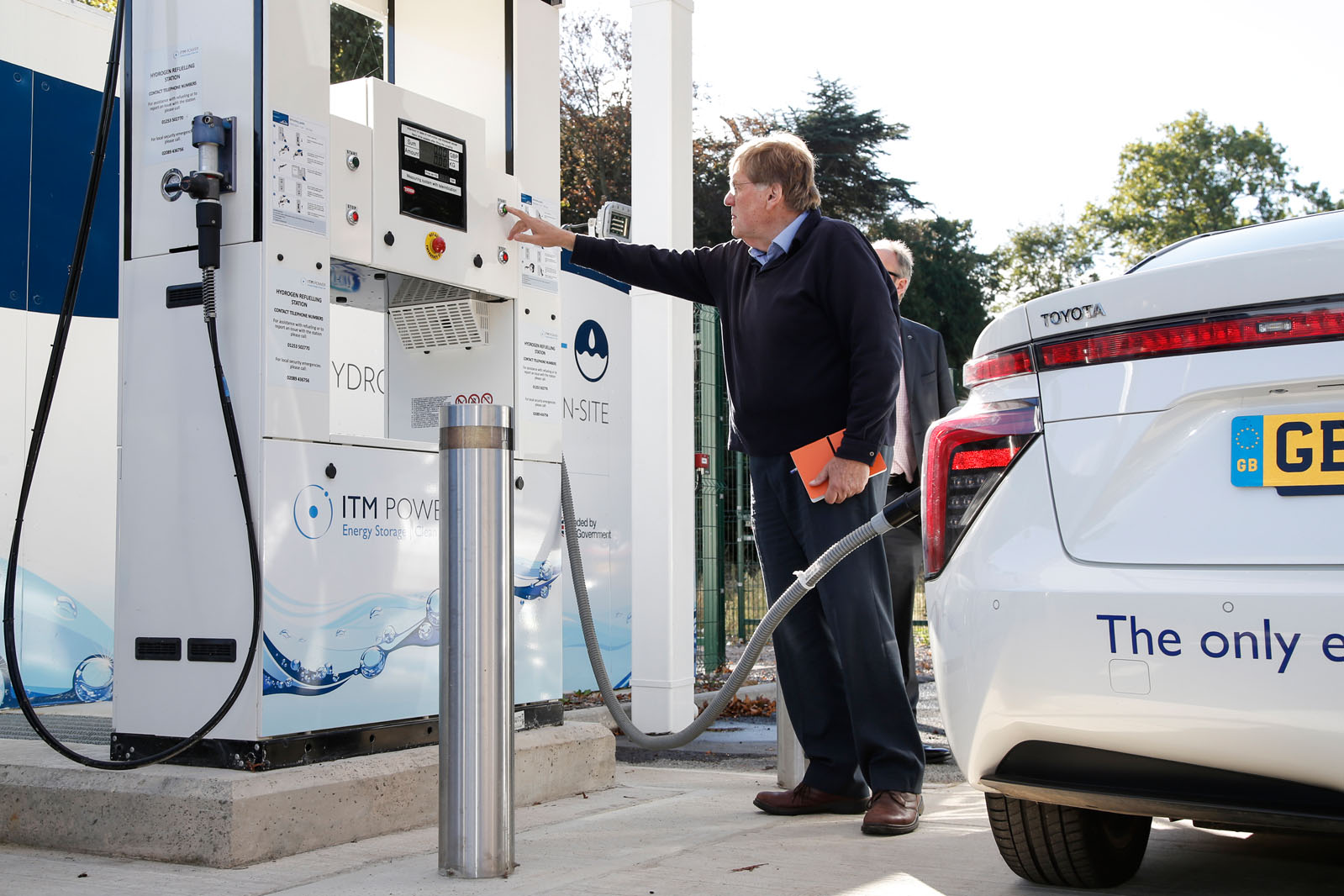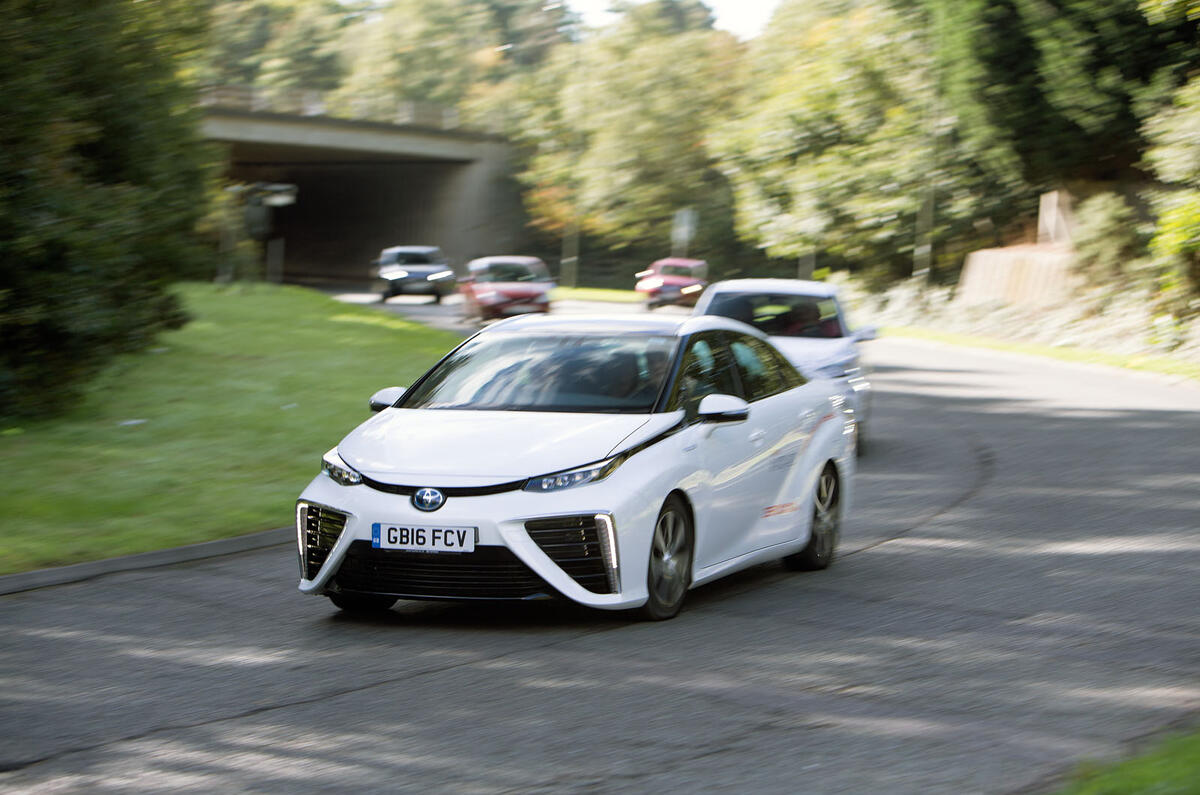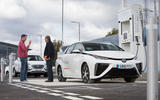It was that word ‘rally’ that caught our attention.
Come to a rally for hydrogen-powered cars, said the invitation from ITM Power, the UK’s only specialist in the production and storage of hydrogen. Join us at one of our existing filling stations, drive to a new one we’re opening in Rainham, Essex, and see how it feels not to emit a single molecule of noxious gas on along the way.
We were hooked. Previous contact with ITM’s boss, Graham Cooley, had convinced me that hydrogen cars were credible and supply of the fuel was expanding. I’d read forecasts of a critical mass of 65 UK hydrogen stations in the medium term, while a drive in the new Toyota Mirai a few months ago had demonstrated the capability of vehicles powered by hydrogen fuel cells.

The plan was for us to join Cooley and his crew at their established filling station beside the National Physical Laboratory in Teddington, Middlesex, on London’s south-western outskirts, then to drive 60-odd miles to a new solar-powered station at Rainham, Essex, the latest of several ITM has under construction. Here, solar power is used to make hydrogen from water with no help from pollution-generating hydrocarbons. This would be the ultimate clean drive.
The plan was that I’d drive a Toyota Mirai, while my colleague Jim Holder would bring the new hydrogen-powered Hyundai ix35 SUV we’re about to add to our test fleet. This would hardly be rallying at WRC level, but it might be just as significant. We pitched up in Teddington at the appointed 10am, and after time taken over photographs and who’s-driving-what, we fell to fuelling the cars.
Filling a hydrogen car is simple. You offer your card to a card reader, taking the dispenser hose when you see a positive response on the screen. Plug the dispenser into your car’s fuel tank aperture, noticing a red ring around the gas pipe that allows the pump to ‘talk’ to the car via infra-red communication. The car grabs the nozzle, there’s a short delay while the pair communicate, a buzz while the system tests itself and verifies all seals and then hydrogen starts to flow at 700bar – and -40deg C – into your tank.

At the end there’s a loud blow-off noise as the pressure is released, you’re invited to remove the nozzle and the job is done. In the Mirai, which holds 60 litres, you’re good for 300 miles-plus, but whereas 60 litres of petrol weighs around 40kg, the full hydrogen tank adds only an eighth of that to the Mirai’s kerb weight.
Anyone familiar with driving to Essex from west London will know there’s a stark choice between 50-odd miles of congested city driving or a longer, more peaceful 68-mile sojourn on the orbital M25 motorway. We chose the latter. Cruising nose to tail, the Toyota and Hyundai did what electric cars do best, cruising smoothly and quietly with the traffic at 60-70mph. The Mirai was roomy and luxurious, the ix35 somewhat more mainstream. Both were not only impressively refined to drive but also, more importantly, intuitive and easy. If we needed reassurance that hydrogen-powered cars need not affect – and might even enhance – our future driving convenience and pleasure, here it was.
Driving along, Cooley reiterated the reasons for his lifelong enthusiasm for hydrogen power. As most people now know, hydrogen is clean and, now the appropriate systems have been designed, easy to handle. Fuel cell stacks are getting smaller, cheaper and easier to accommodate in cars. Toyota talks of the Mirai and its prospects (700 built last year, 30,000 planned for 2020) much as it did the Prius 20 years ago, and that seminal hybrid model’s worldwide sales last year passed eight million. Those are the givens.

But Cooley’s big thing is hydrogen’s potential as an energy storage medium – on a huge scale. There are frequent times when the national potential for generating electricity surpasses demand, such as when the wind rotates turbines at night, yet it’s lost because we don’t have an economic means of storage. In future, ITM-style hydrogen generators could convert that power to hydrogen, store it in the gas grid (which is three times the size of the power grid) and recover it for conversion back to electric power when demand dictates. It’s efficient and quick, says Cooley, it’s called grid balancing and Big Government is taking it very seriously. In such an environment, a hydrogen infrastructure for cars suddenly looks practical – and Shell, with whom ITM already has an embryonic deal, thinks so too.
By the time we arrived in Essex, I was profoundly impressed. The Mirai’s performance helped: we used exactly one kilogram of fuel – priced on the bowser at £9.95 per kilo – for 68.5 miles. Mr Holder’s Hyundai did the same. In petrol terms, that’s around 26mpg, and it implies a touring range for the Mirai of 360 miles. For the time being, hydrogen costs around a third more than petrol, but Cooley says that price will fall. “Watch hydrogen,” he told us as we departed back to the office. “It’s going places.”



















































Join the debate
Add your comment
Why bother
Renault Zoe 41kwh today (NEDC I know), Chevrolet Bolt (LHD only 2017), Model 3 2017-18, Leaf 2 predicted 2017, Hyundai Ionic 2nd Gen 2018.... it goes on.
I hope FCVs die a quick death.
The biggy is of course distribution of H2 from sources far away, and now they are pinning their hopes on using the natural gas distribution network. Just wait until the H2 in those pipes makes them brittle and crack, then see the cost benefit of having to replace the entire NG distribution system!
If distribution and H2 fueling stations were entirely paid for by the companies running them (big oil) then I wouldn't object, but this huge cost will unfortunately be passed on to the taxpayer.
Future